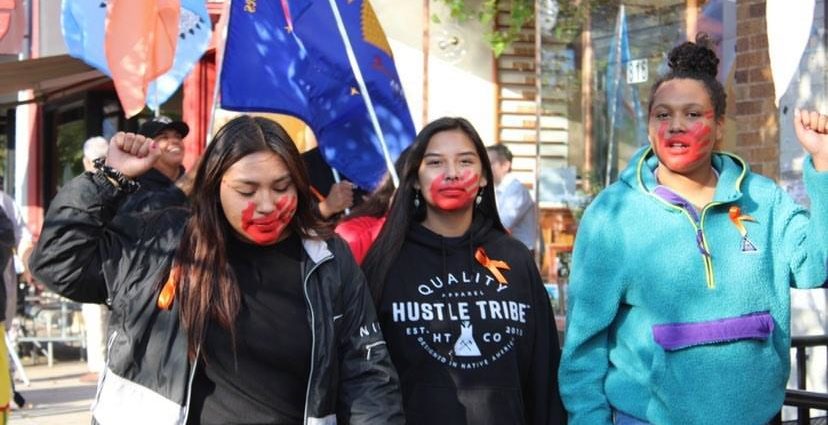“To be born American Indian today is to have survived a holocaust of a very particular kind, one whose evidence is everywhere, all the time.”
-Dina Gilio-Whitaker
On Wednesday Oct.4th, over 40 students marched down Massachusetts Street, The students were joined with staff and local tribal people, all carrying and representing 40 or more Tribal Nation Flags. Each representing their cause; marching in honor of Indigenous Peoples day, representing MMIW Movement, AIM, holding No More Stolen Sisters Signs, red handprints across their faces, and all were wearing orange ribbons pinned to their shoulders and chest. For those who may not be familiar with the importance of orange ribbons carried with the slogan of ‘Haskell Remembers’ or Orange Shirts Day, here is some insight.
The incorporation of the orange ribbons began during Haskell Homecoming Week, which took place after the original Orange Shirt Day on September 30th and before Indigenous Peoples Day on October 14th. Thanks to donations of orange ribbons and supplies, a small group of students made approximately 200 ribbon pins. The Orange Shirt Day began with our First Nations relatives;
“…The annual Orange Shirt Day on September 30th …It is an opportunity to create meaningful discussion about the effects of Residential Schools and the legacy they have left behind. A discussion all Canadians can tune into and create bridges with each other for reconciliation. A day for survivors to be reaffirmed that they matter, and so do those that have been affected. Every Child Matters, even if they are an adult, from now on.
The date was chosen because it is the time of year in which children were taken from their homes to residential schools, and because it is an opportunity to set the stage for anti-racism and anti-bullying policies for the coming school year. It is an opportunity for First Nations, local governments, schools and communities to come together in the spirit of reconciliation and hope for generations of children to come.” (Orange Shirt Day: Every Child Matters)
As American Indians and First Nations people we have all been affected by boarding schools and/ or residential schools, Our greatgrandparents, grandparents, and parents. We all live with lasting effects. But we now have the selfawareness, knowledge, and tools to heal ourselves, our families, and our communities.
It is important for Haskell to recognize the pillars that our University is built upon as well as celebrate what we have become. Former United States Indian Industrial Training School, Haskell Institute, and current Haskell Indian Nations University; our constant reminders are everywhere all the time, on the southeast side of campus there is a cemetery where children lay at rest. At the cultural center there is a pair of child-size handcuffs on display. Haskell does have a dark history, but also a continuing journey and legacy. In honor of our ancestors who had no choice in coming to school, we recognize that times are different now. We are very fortunate to have this opportunity at higher education. There are many alumni and students who are proud to be a Haskell Indian as they should. As Haskell students and alumni, it is our responsibility to honor the memory of the children who were sent to the original Haskell Institute, the children who survived, and the children who never returned home.
AHO
Featured Image by Summer Mohsen

